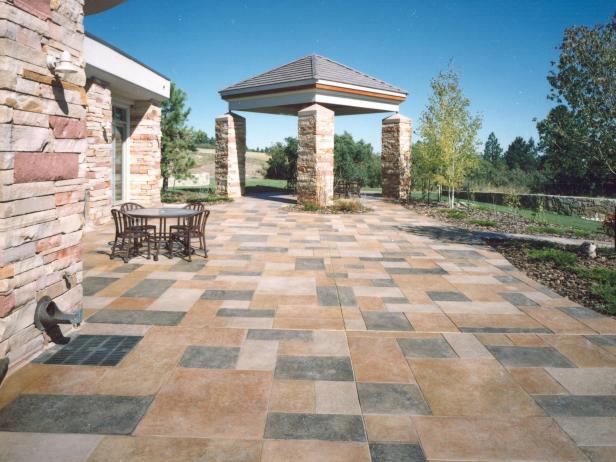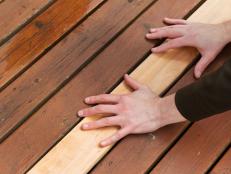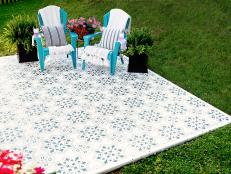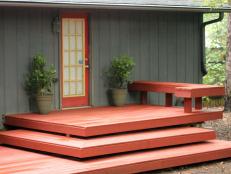Sealers, Paints and Stains 101 for Concrete Patios
Choose the right sealant to keep your patio in tiptop shape.
When concrete patios are left to their own devices, nature may compromise durability and appearance. Winter freezing/thawing cycles could create cracks and flaking, and UV rays may whitewash the surface. Sealing your patio will help prevent this, deter stains and revive appearance with the color of your choice.
Read on to learn if a sealer, paint or stain is best for your concrete patio's maintenance and your desired aesthetic.
Sealer Pros and Cons

Rust-Oleum
There are two ways to use sealers on your concrete patio. One is as a standalone sealer over bare concrete. The other is to use the sealer on top of a concrete stain or paint, says Kerri Schlenker, Rust-Oleum brand manager for high performance coatings. "A stain isn't going to offer protection, only color, so the sealer over it would protect the color and the concrete in general," she says.
Sealers that are film-forming (meaning they leave a sheen on the surface) come in two types — solvent-based and water-based. According to ChemMasters, a manufacturer of concrete coatings, solvent-based sealers are high gloss and darken concrete, while water-based sealers are low gloss with minimal darkening and/or color change.
If you'd like stain protection from food, fire/water features or flower pots and planters, choose a film-forming sealer. However, one drawback is because these sealers form a film, they may create a slippery surface on the concrete. Consider them for stamped concrete and broom-finished concrete patios. And to prevent the sealer from yellowing your concrete due to excessive UV exposure, look for a film-forming sealer with UV stable resin.
A second class of sealer is known as a penetrating sealer, or a water-repellent sealer. This type seeps into the concrete surface and is best for smooth concrete and broom-finished concrete. Penetrating sealers will offer freeze/thaw protection and, of course, prevent water absorption, but do not offer stain protection. Penetrating sealers give a matte finish to concrete and do not add slippage to the surface.
Both film-forming and water-based sealers come in acrylic and epoxy varieties. Generally, epoxy sealers are applied to extremely high-traffic areas and to prevent chemical spills because they offer excellent protection. Acrylic sealers are often used to block water penetration for residential applications and decorative concrete.
Keep in mind that applying any solvent-based sealer will require chemical clean-up, while water-based are easier to clean with soap and water. Choosing which type can be a tradeoff between long-term maintenance and ease of application. Schlenker says that the "easiest product to use and apply is water- or latex-based, but an oil-based or solvent-based [product] will last longer over time, requiring less maintenance."
Paint Pros and Cons

Concrete paints share similarities with paints for other applications in that they come in two types: oil-based or water-based/latex varieties. Oil-based paints are more durable, but take longer to dry, have higher odor/VOC levels and require paint thinner to clean up. Water-based/latex paints are not as durable, but have faster dry times, are more eco-friendly and can be cleaned up with soap and water.
A major pro of paints is that they come in many different colors, not just natural tints, so you can completely customize your outdoor flooring. However, know that paints do require reapplication and may peel or flake, especially if the patio is exposed to full sun, precipitation and foot traffic.
Stain Pros and Cons

The Concrete Network
While sealers mainly darken a concrete patio's appearance and paints turn the surface completely opaque, stains offer a middle ground with a variety of colorful tones and textures dependent upon application. They come in two types: acid-based chemical and water-based acrylic. Both will permanently apply color to your concrete patio.
An acid-based stain etches the surface of the concrete, allowing the color to penetrate so it won't fade or chip, according to The Concrete Network. These stains are limited to a color palette of earth tones, like browns, terracotta and pastel blue-green. Water-based acid stains will also permanently bond to concrete, but are available in a wider variety of colors, from black to translucent shades.
Generally, acid stains are a multi-step process and more complex than applying a sealer or paint. When paired with concrete dyes, almost any color or pattern you desire is achievable, turning your concrete patio into artwork. Dyes, which are not chemically reactive but still seep permanently into the concrete's pores, dry quicker than an acid-stain and take less clean-up. Because of this, careful application is required.
Note that one major drawback to stains is that they won't hide existing imperfections in your concrete, such as cracks. They should also be applied to clean surfaces because any existing sealers, grease or dirt on your concrete will make for a patchy application. After stains are applied, they must be sealed for further protection. Often, a sealer must be reapplied every few years for long-term color maintenance.
Ultimately, when choosing among a sealer, paint or stain, consider your level of DIY expertise, project time commitment, how often you'd like to do routine maintenance and your desired color and design for your patio. These preferences will guide you to choose the best sealant for your patio.














































